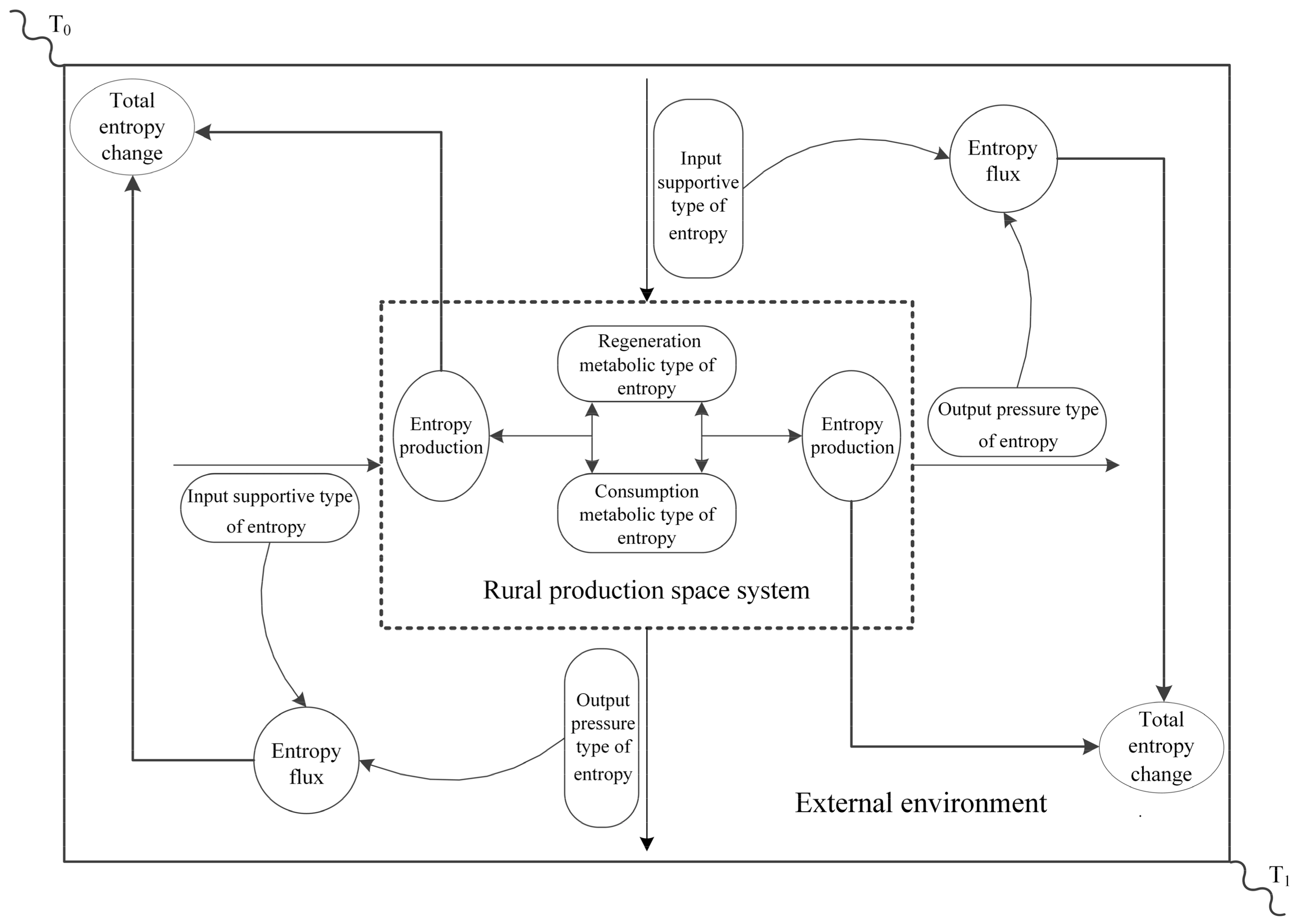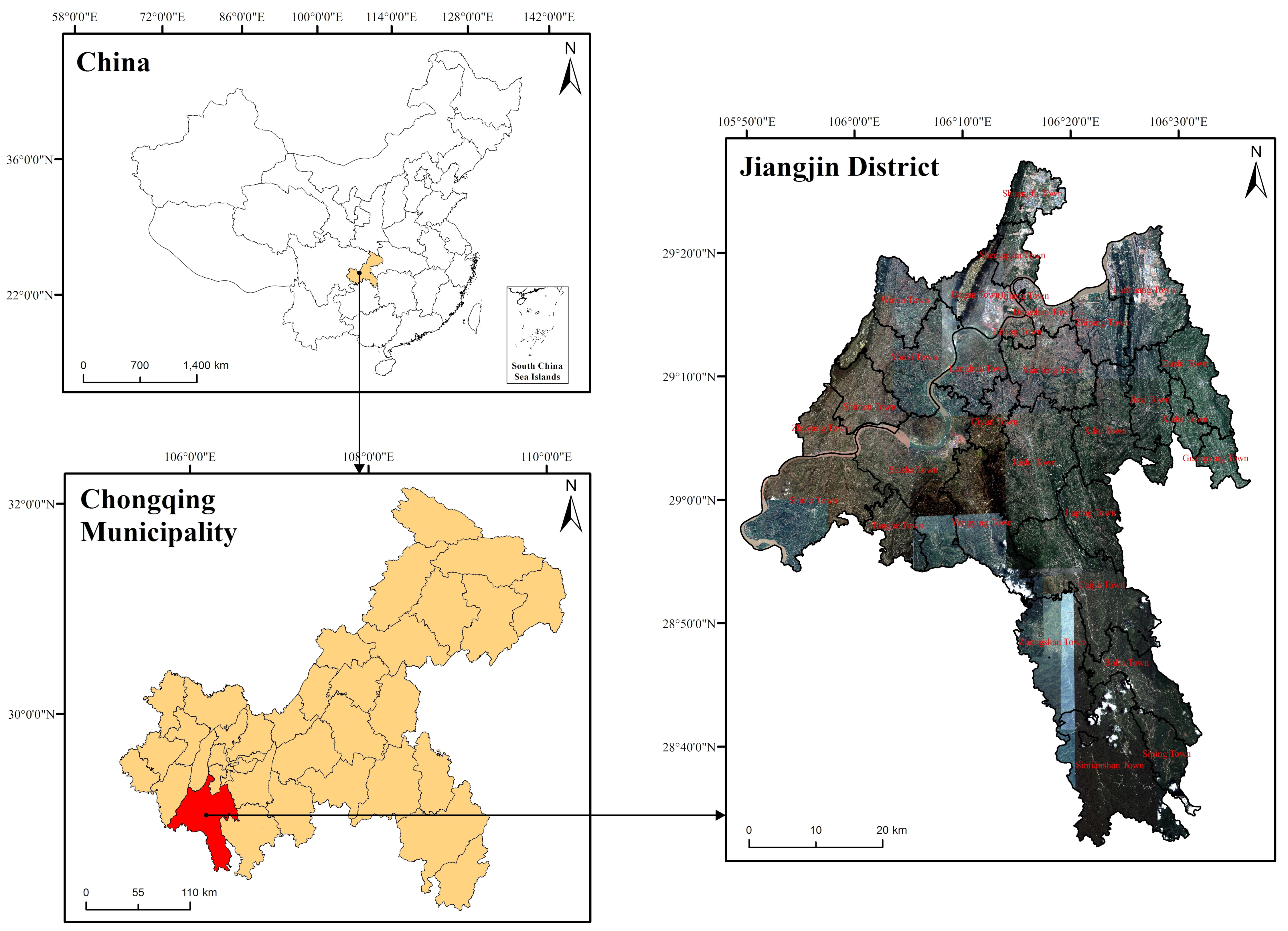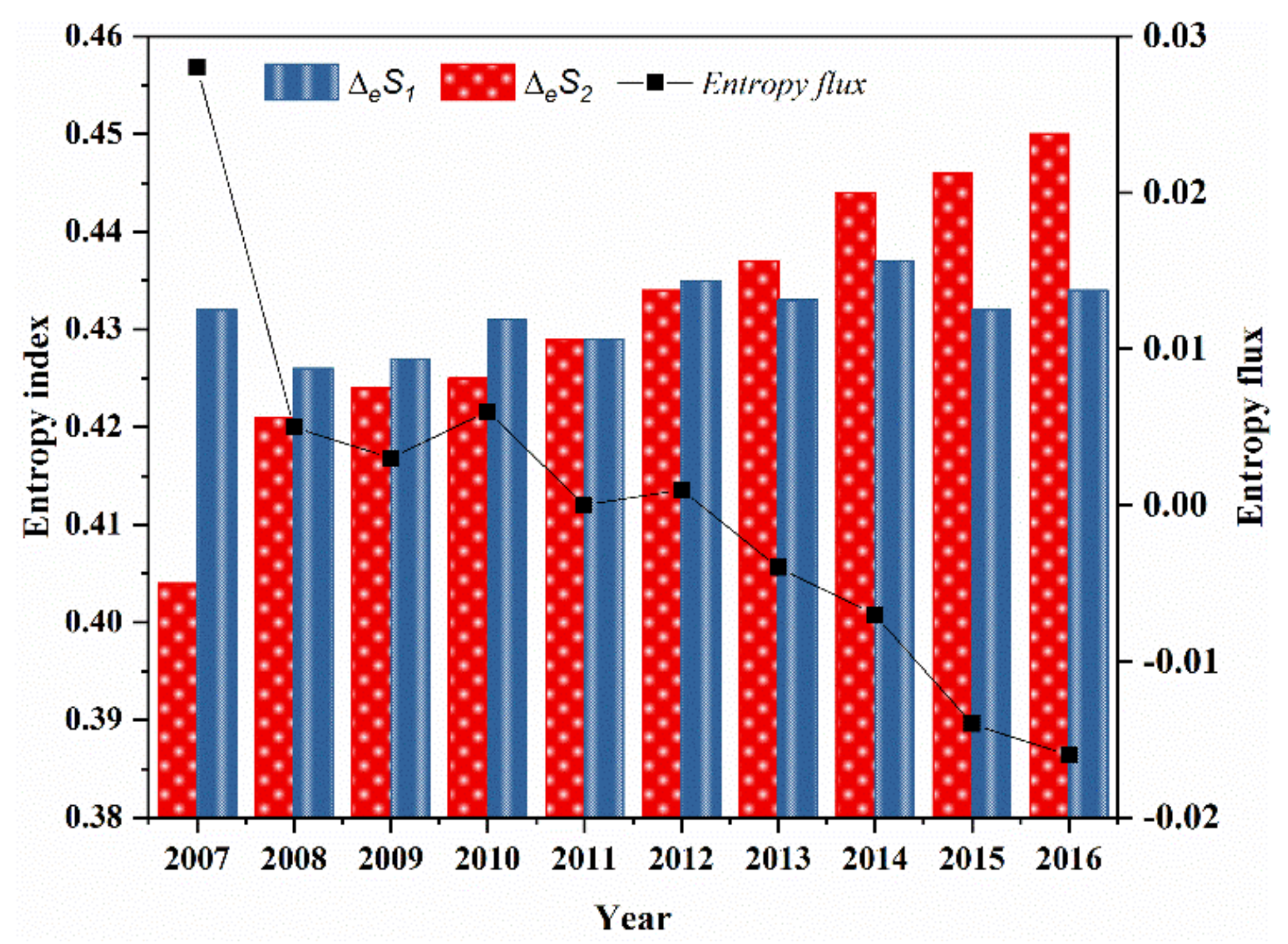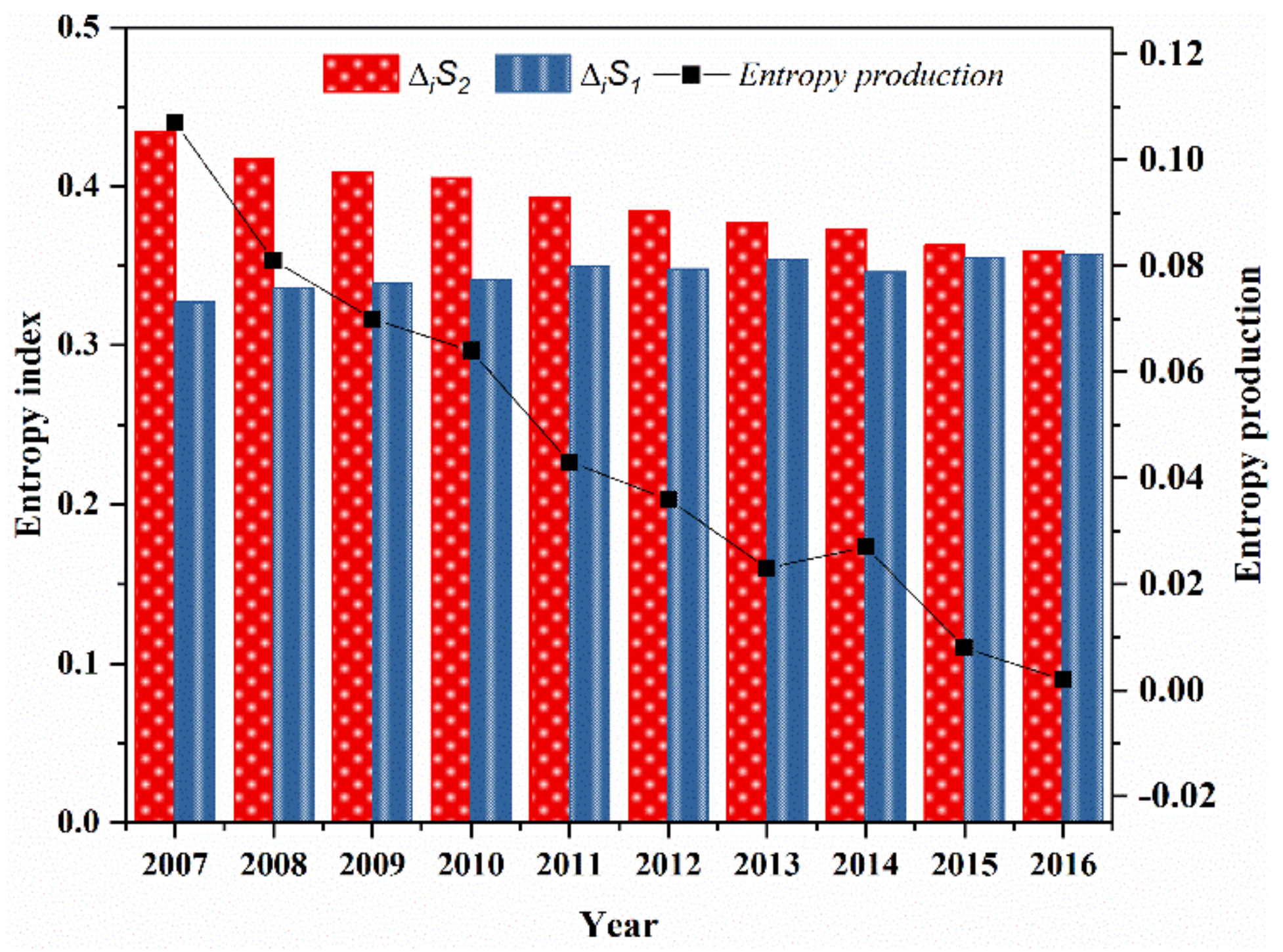Understanding the Rural Production Space System: A Case Study in Jiangjin, China
Abstract
1. Introduction
2. Theoretical Basis and Quantitative Analysis Model
2.1. Dissipative Structure Theory and Entropy Theory in Rural Studies
2.2. Dissipative Structure Features of RPSS
- Open System. RPSS exchanges energy and matter with its exterior, which is reflected in the diversity of input and output relations within a system and between a system and its external environment. By contrast, RPSS actively and continuously absorbs negentropy (i.e., reverse entropy) from the external environment by conducting material circulation, energy flow, and information transformation. This type of input is external market demand-oriented and manifests as support for policy, finance, and high-tech equipment. RPSS exports products and services to the exterior environment to promote orderly development. This output appropriately utilizes land resources to set up grain production areas, vegetable cultivation areas, and fruit forests. It also develops rural non-material cultural resources, such as unique dwellings or ancestral halls. The objective flow of input and output indicates that RPSS is an open system.
- Far from Equilibrium. Systems that are subject to energy and matter flow can be driven far from equilibrium states, i.e., a ‘nonlinear’ regime. Exchanges amongst various flows within RPSS happen continuously. At the temporal scale, exchanges are dynamic factor flows caused by the unbalanced development speed of factors, such as natural resources, production subjects, and mechanical equipment, within a system. At the spatial scale, exchanges are dynamic economic flows caused by the agglomeration of potential economic differences that exist in the spatial layout of a rural industry. Hence, when RPSS is far from equilibrium, the operational state of RPSS changes over time through various flows within a system and between a system and its external environment.
- Nonlinearity Regime. Three pairs of relationships in RPSS contribute to the formation of a nonlinear regime of man-land relationship, as follows: The relationships amongst factors, between factors and the system, and between systems and the external environment. All these relationships exhibit characteristics of mutual contact, coordination, and restriction. Rural multiple subjects are interrelated and interact through the utilization of labour force, land resources, and capital by media, such as agricultural production and marketing information, which are important component of rural economy. These mutual effects and feedback amongst the major internal factors of RPSS exhibit a nonlinear relationship, which helps RPSS evolve into an orderly and functional self-organization structure.
- Random Fluctuation. As a result of random fluctuations or other random factors, such as slight inhomogeneities or imperfections, a system evolves into one of many possible states. In general, RPSS can achieve a stable equilibrium, at the macro level, over a certain period. At the micro level, however, the labour force, land resources, capital, and other driving factors keep flowing amongst multiple rural subjects. Therefore, the quantity and quality of products in a rural area also fluctuate. This fluctuation phenomenon at the micro level is called the micro fluctuation of a system. If new types of agribusinesses crop up, then their sudden presence can sharply break the balance of resource allocation, thereby resulting in huge (e.g., considerably larger than macro) fluctuations in RPSS. Micro fluctuations will not exert a substantial influence on a system, but a huge fluctuation can lead to a disruptive change in system structure.
2.3. Entropy Change Mode of RPSS
- Input supportive type of entropy (∆eS1);
- Output pressure type of entropy (∆eS2);
- Consumption metabolic type of entropy (∆iS2);
- Regeneration metabolic type of entropy (∆iS1).
2.4. Information Entropy Model of RPSS
3. The Empirical Study: Evolution of RPSS Using Information Entropy
3.1. Study Area
3.2. Data Acquisition and Data Management
3.2.1. Data Resource
- Quantity of fertilizer pollution = Quantity of chemical fertilizer(purity) × Inflow coefficient;
- Quantity of crop straw pollution = Crop yields × Straw yield coefficient × (1-Straw utilization ratio) × Nutrient content of straw × Inflow coefficient;
- Quantity of livestock and poultry breeding pollution = Total breeding × Coefficient of fecal discharge × Average fecal contaminant content × Inflow coefficient.
3.2.2. Establishment of the Index System of the Evolution of RPSS
- Indicators of the input supportive type of entropy (A1–A10) represent the productivity of the natural environment, the productivity of multiple rural subjects in RPSS and the supporting role of RPSS.
- Indicators of the output pressure type of entropy (B1–B10) represent the ability of rural multiple subjects to utilize and release energy substances and to reflect the pressures undertaken by RPSS.
- Indicators of the consumption metabolic type of entropy (C1–C8) represent the consumption metabolic capability of RPSS and reflect the negative impact on the environment due to the waste and pollutants discharged in rural production.
- Indicators of the regeneration metabolic type of entropy (D1–D8) represent the regeneration metabolic ability of RPSS, the environment protection and pollution treatment ability of human beings and resilience to natural disasters per RPSS.
3.2.3. Data Standardization
3.3. Results
3.3.1. Entropy Flux
3.3.2. Entropy Production
4. Discussion and Conclusions
4.1. Discussion
4.2. Conclusions
- (1)
- RPSS belongs to the dissipative structure category, with a series of characteristics, including an opening system, being far from equilibrium, a nonlinearity regime, and random fluctuations. The evolution process of RPSS is a direct consequence of the entropy changes of RPSS and it shows the complex human–environment interaction of rural production activities. Therefore, entropy theory can be used to understand the input and output of matter, energy, and information in RPSS and provides a method for expounding RPSS systematically to realize sustainable rural developments.
- (2)
- RPSS is affected by many factors that can be divided into input supportive type of entropy, output pressure type of entropy, consumption metabolic type of entropy and regeneration metabolic type of entropy, in accordance with entropy theory. RPSS presents different states under the interaction of humans and the environment, i.e., the combined effects of entropy production and entropy flow.
- (3)
- The four types of entropy can be used to characterize the interaction of the influencing factors of RPSS in the study area. Factors supporting rural development, such as sufficient funds, favorable policies, and good infrastructure, were input into RPSS of Jiangjin and interacted with each other, presenting that the input supportive type of entropy presents a trend of fluctuating upward from 2007 to 2016. Entropy generation and entropy flow can characterize the interaction process between humans and the environment. The entropy flux of RPSS showed an overall decreasing trend and the entropy production of RPSS fluctuates downward in Jiangjin from 2007 to 2016. The results indicated the rural output benefits were higher than the negative benefits on villages on the base of the consumption of resources per unit when stakeholders strengthen the protection of the rural environment and reduce rural pollution. These results can be used to explain the situation of the study area and guide the practice of rural production space development.
Author Contributions
Funding
Acknowledgments
Conflicts of Interest
References
- Liu, Y.S.; Li, Y.H. Revitalize the world’s countryside. Nature 2017, 548, 275–277. [Google Scholar] [CrossRef]
- OECD Report: Demographic Change and Local Development. Shrinkage, Regeneration and Social Dynamics. Available online: https://www.oecd-ilibrary.org/development/demographic-change-and-local-development_9789264180468-en (accessed on 28 November 2012).
- ESPON Policy Brief: Shrinking Rural Regions in Europe. Available online: https://www.espon.eu/rural-shrinking (accessed on 23 October 2017).
- Statistical Communiqué of the People’s Republic of China on the 2017 National Economic and Social Development. Available online: http://www.stats.gov.cn/tjsj/zxfb/201902/t20190228_1651265.html (accessed on 28 February 2019).
- Zhang, X.L. Study on the Rural Space System and Its Evolution: A Case Study of South Jiangsu; Nanjing Normal University Press: Nanjing, China, 1999. [Google Scholar]
- Nakamura, D. Alternative spatial structure for sustainable rural economy: A note on socially optimal firm location. Int. Reg. Sci. Rev. 2016, 41, 86–102. [Google Scholar] [CrossRef]
- Daly, S. Producing healthy outcomes in a rural productive space. J. Rural Stud. 2015, 40, 21–29. [Google Scholar] [CrossRef]
- Horlings, L.; Marsden, T. Exploring the ‘New Rural Paradigm’ in Europe: Eco-economic strategies as a counterforce to the global competitiveness agenda. Eur. Urban Reg. Stud. 2014, 21, 4–20. [Google Scholar] [CrossRef]
- Marsden, T. European Society for Rural Sociology. Sociol. Rural. 2016, 56, 597–615. [Google Scholar] [CrossRef]
- Senger, I.; Borges, J.; Machado, J. Using the theory of planned behavior to understand the intention of small farmers in diversifying their agricultural production. J. Rural Stud. 2017, 49, 32–40. [Google Scholar] [CrossRef]
- Schall, D.; Lansing, D.; Leisnham, P.; Shirmohammadi, A.; Montas, H. Understanding stakeholder perspectives on agricultural best management practices and environmental change in the Chesapeake bay: AQ methodology study. J. Rural Stud. 2018, 60, 21–31. [Google Scholar] [CrossRef]
- Gullino, P.; Devecchi, M.; Larcher, F. How can different stakeholders contribute to rural landscape planning policy? The case study of Pralormo municipality (Italy). J. Rural Stud. 2018, 57, 99–109. [Google Scholar] [CrossRef]
- Lowe, P.; Murdoch, J.; Marsden, T.; Munton, R.; Flynn, A. Regulating the new rural spaces: The uneven development of land. J. Rural Stud. 1993, 9, 205–222. [Google Scholar] [CrossRef]
- Marsden, T. Beyond agriculture? Regulating the new rural spaces. J. Rural Stud. 1995, 11, 285–296. [Google Scholar] [CrossRef]
- Holmes, J. Impulses towards a multifunctional transition in rural Australia: Gaps in the research agenda. J. Rural Stud. 2006, 22, 142–160. [Google Scholar] [CrossRef]
- Zagata, L.; Sutherland, L.A. Deconstructing the ‘young farmer problem in Europe’: Towards a research agenda. J. Rural Stud. 2015, 38, 39–51. [Google Scholar] [CrossRef]
- Mitchell, C.J.A. Creative destruction or creative enhancement? Understanding the transformation of rural spaces. J. Rural Stud. 2013, 32, 375–387. [Google Scholar] [CrossRef]
- Liu, Y.S.; Long, H.L.; Chen, Y.F.; Wang, J.Y.; Li, Y.R.; Li, Y.H.; Yang, Y.Y.; Zhou, Y. Progress of research on urban-rural transformation and rural development in China in the past decade and future prospects. J. Geogr. Sci. 2016, 26, 1117–1132. [Google Scholar] [CrossRef]
- Bertalanffy, L.V.; Lin, Y.K.; Wei, H.S. (trans.) General System Theory; Tsinghua University Press: Beijing, China, 1987. [Google Scholar]
- Wei, H.S.; Zeng, G.P. System Theory; Tsinghua University Press: Beijing, China, 1995. [Google Scholar]
- Harvey, D. The Urbanization of Capital; Johns Hopkins Press: Baltimore, MD, USA, 1985. [Google Scholar]
- Gregory, D.; Urry, J. Social Relations and Spatial Structures; St. Martin’s Press: New York, NY, USA, 1985; pp. 1–8. [Google Scholar]
- Halfacree, K. Rural space: Constructing a three-fold architecture. In Handbook of Rural Studies; Cloke, P., Marsden, T., Mooney, P.H., Eds.; Sage Publications: London, UK, 2006. [Google Scholar]
- Halfacree, K. Trial by space for a ‘radical rural’: Introducing alternative localities, representations and lives. J. Rural Stud. 2007, 23, 125–141. [Google Scholar] [CrossRef]
- Wang, C.; Li, H.Y. Conceptual and research frameworks of rural production space system. Prog. Geogr. 2017, 36, 913–923. (In Chinese) [Google Scholar]
- Prigogine, I. Structure, Dissipation and Life. Theoretical Physics and Biology, Versailles; North-Holland Publ. Company: Amsterdam, The Netherlands, 1969. [Google Scholar]
- Kondepudi, D.; Prigogine, I. Modern Thermodynamics from Heat Engines to Dissipative Structures, 2nd ed.; Wiley: Hoboken, NJ, USA, 2014. [Google Scholar]
- Clausius, R. Mechanical Theory of Heat; John van Voorst: London, UK, 1867. [Google Scholar]
- Boltzmann, L. The Second Law of Thermodynamics. In Theoretical Physics and Philosophical Problems. Vienna Circle Collection; McGuinness, B., Ed.; Springer: Dordrecht, The Netherland, 1974; pp. 13–32. [Google Scholar]
- Prigogine, I. Etude Thermodynamique des Processus Irreversibles; Desoer: Liege, CA, USA, 1947. [Google Scholar]
- Shannon, C.E. A Mathematical Theory of Communication. Bell Syst. Tech. J. 1948, 27, 379–423. [Google Scholar] [CrossRef]
- Ohayon, R.; Soize, C.; Sampaio, R. Variational-Based Reduced-Order Model in Dynamic Substructuring of Coupled Structures Through a Dissipative Physical Interface: Recent Advances. Arch. Omput. Methods Eng. 2014, 21, 321–329. [Google Scholar] [CrossRef]
- Okubo, T.; Kimura, K.; Kimura, H. Dissipative structures formed in the course of drying the colloidal crystals of monodispersed polystyrene spheres on a cover glass. Colloid Polym. Sci. 2002, 280, 1001–1008. [Google Scholar] [CrossRef]
- Goldbeter, A. Biological Rhythms as Temporal Dissipative Structures. In Advances in Chemical Physics: Special Volume in Memory of Ilya Prigogine; Rice, S.A., Ed.; Wiley: Hoboken, NJ, USA, 2007; Volume 135. [Google Scholar]
- Smith, C. Transformation and Regeneration in Social Systems: A Dissipative Structure erspective. Sysrems Res. 1986, 3, 203–213. [Google Scholar] [CrossRef]
- Zhu, Q.M.; Liu, X.Y.; Zhang, H. Research on the Safety Economic Management System based on the Dissipative Structure Theory. Procedia Eng. 2012, 45, 259–263. [Google Scholar] [CrossRef][Green Version]
- Gu, J.C.; Li, J.F.; Yao, F.J. Analysis on the Relationship between Improving Ecological Environment and Rural Economic Development in Liemayun Vliiage, Qianxi County, Hebei Province. Ecol. Econ. 1997, 3, 26–33. (In Chinese) [Google Scholar]
- Wang, X.M.; Li, M.; Yang, J.; Zhang, J.S. Study on Construction Management System for Villages and Small Towns Based on Dissipative Structure. In Proceedings of the 2009 International Conference on Management and Service Science, Wuhan, China, 20–22 September 2009. (In Chinese). [Google Scholar]
- Liu, T. The Study of Dynamic Entropy Model of Rural Ecological Environment Protection Based on Dissipation Structure. Ecol. Econ. 2012, 12, 185–188. (In Chinese) [Google Scholar]
- Wang, X.J.; Gao, B. Innovative Mechanism of Rural Organization Based on Self-Organization. Asian Agric. Res. 2011, 3, 135–138. (In Chinese) [Google Scholar]
- Zhuang, J.C.; Wang, C.Y. Research on the Sustainable Development of Beautiful Countryside through Compound System Perspective: Case Study of Hongyan Village in Guangxi Province. Issues Agric. Econ. 2016, 37, 9–17. Available online: http://www.cnki.com.cn/Article/CJFDTotal-NJWT201606002.htm (accessed on 31 June 2016). (In Chinese).
- Wang, C.; Zhou, M.M.; Li, H.Y.; He, Y.Z.; Ma, X.S. Research on the order of rural production space system based on a system entropy model in the dissipative structure. Geogr. Res. 2019, 38, 619–639. (In Chinese) [Google Scholar]
- OECD. Environmental Indicators: OECD Core Set; Organization for Economic Co-operation and Development: Paris, France, 1994. [Google Scholar]
- Lin, Z.M.; Bin, X. Sustainability analysis of the urban ecosystem in guangzhou city based on information entropy between 2004–2010. J. Geogr. Sci. 2013, 23, 417–435. [Google Scholar] [CrossRef]
- Li, H.B.; Zhang, X.L. Spatial Extension in the Context of Urban and Rural Development: Village Recession and Reconstruction. Reform 2012, 1, 148–153. Available online: http://www.cnki.com.cn/Article/CJFDTotal-REFO201201022.htm (accessed on 31 January 2012). (In Chinese).
- Li, H.B.; Zhang, X.L.; Wu, J.G.; Zhu, B. Spatial Pattern and Its Driving Mechanism of Rural Settlements in Southern Jiangsu. Sinentia Geogr. Sin. 2014, 34, 438–446. (In Chinese) [Google Scholar]
- Li, H.B.; Zhang, X.L.; Wu, Q.Y.; Wang, Y.H. Characteristics and Mechanism of Rural Settlements Spatial Reconstruction in Developed Areas—A Case Study of Southern Jiangsu. J. Nat. Resour. 2015, 30, 591–603. (In Chinese) [Google Scholar]
- Li, H.B.; Hu, X.L.; Zhang, X.L.; Li, Z.; Yuan, Y. On the analysis of rural space. Prog. Geogr. 2018, 37, 581–590. (In Chinese) [Google Scholar]
- Long, H.L.; Ge, D.Z.; Zhang, Y.N.; Tu, S.S.; Qu, Y.; Ma, L. Changing man-land interrelations in China’s farming area under urbanization and its implications for food security. J. Environ. Manag. 2018, 209, 440–451. [Google Scholar] [CrossRef] [PubMed]
- Woods, M. Rural geography. In International Encyclopedia of Human Geography; Kitchin, R., Thrift, N., Eds.; Elsevier: Oxford, MI, USA, 2009; Volume 9, pp. 429–441. [Google Scholar]
- Long, H.L.; Li, Y.R.; Liu, Y.S.; Woods, M.; Zou, J. Accelerated restructuring in rural China fueled by “increasing vs. decreasing balance” land-use policy for dealing with hollowed villages. Land Use Policy 2012, 29, 11–22. [Google Scholar] [CrossRef]
- Long, H.L. Land consolidation: An indispensable way of spatial restructuring in rural China. J. Geogr. Sci. 2014, 24, 211–225. [Google Scholar] [CrossRef]
- Tu, S.S.; Long, H.L. Rural restructuring in China: Theory, approaches and research prospect. J. Geogr. Sci. 2017, 27, 1169–1184. [Google Scholar] [CrossRef]
- Byeon, J.H. Non-Equilibrium Thermodynamic Approach to the Change in political Systems. Syst. Res. Behav. Sci. 1999, 16, 283–291. [Google Scholar] [CrossRef]
- Li, Z.Q.; Liu, C.M. Research on the Entropy Change Model for Entrepreneurs’ Creative Behavior System Based on Dissipative Structure. China Soft Sci. 2009, 8, 162–166. (In Chinese) [Google Scholar]
- Yang, S.; Pang, J.; Ji, Z.M. The Evolution Mechanisms and Law of Lianyungang Port-city System Based on Principles of Dissipative Structure. Sci. Geogr. Sin. 2011, 31, 781–787. (In Chinese) [Google Scholar]
- Woods, M. Performing rurality and practising rural geography. Prog. Hum. Geogr. 2010, 34, 835–846. [Google Scholar] [CrossRef]




| Items | Symbols or Formulas | Meaning |
|---|---|---|
| Input supportive type of entropy | ∆eS1 | Determine the supporting function of RPSS |
| Output pressure type of entropy | ∆eS2 | Determine the pressure exerted by rural production development on RPSS |
| Consumption metabolic type of entropy | ∆iS2 | Determine the negative effects of various production behaviours on the environment of RPSS |
| Regeneration metabolic type of entropy | ∆iS1 | Determine the environmental protection and pollutant treatment capability of human in RPSS |
| Entropy flux | ∆eS2 − ∆eS1 | Determine the interactive effect of the activities of multiple subjects between the production and environmental protection of RPSS; reflect the carrying capacity of RPSS on rural production development; represent the coordination of RPSS. |
| Entropy production | ∆iS2 − ∆iS1 | Determine the interactive effects of environmental pollution and purification on RPSS; reflect the regeneration capacity of RPSS on the metabolic process; represent the vitality of the system. |
| Total entropy change | (∆eS2 − ∆eS1) + (∆iS2 − ∆iS1) | Determine the evolution direction of RPSS; represent the degree of order and health condition of RPSS. A ‘positive entropy’ indicates an increase in the disorder degree of RPSS, whereas a ‘negative entropy’ indicates an increase in the order degree of RPSS. |
| Indicator Type | Indicators | Units |
|---|---|---|
| Input supportive type (A) | Gross output of grain A1 | ×104 t |
| Gross output of vegetables A2 | ×104 t | |
| Gross output of fruits A3 | ×104 t | |
| Gross output of aquatic products A4 | ×104 t | |
| Gross output of meat A5 | ×104 t | |
| Primary industry gross domestic product A6 | ×108 RMB | |
| Gross output township enterprises A7 | ×108 RMB | |
| Comprehensive income from rural tourism A8 | ×108 RMB | |
| Per capita net income of rural residents A9 | RMB | |
| Commercial rate of agricultural products A10 | % | |
| Output pressure type (B) | Population of rural employees B1 | ×104 person |
| Rural tourist number B2 | ×108 person | |
| Expenditure for agriculture, forest and water conservation B3 | ×104 RMB | |
| Agricultural water consumption B4 | ×108 m3 | |
| Agricultural fertilizer consumption B5 | t | |
| Usage of plastic film B6 | t | |
| Usage of pesticide B7 | t | |
| Power consumption of rural production B8 | ×104 kW h | |
| Cropping index B9 | % | |
| Intensity of agricultural economic activity B10 | RMB/m2 | |
| Consumption metabolic type (C) | Quantity of fertilizer pollution C1 | t |
| Quantity of crop straw pollution C2 | t | |
| Density of livestock and poultry breeding pollution C3 | t/hm2 | |
| Agricultural source chemical oxygen demand C4 | t | |
| Agricultural source amino-nitrogen emission C5 | t | |
| Quantity of township enterprise wastewater effluent C6 | ×104 t | |
| Pollutant quantity in flue gas of township enterprise C7 | ×104 t | |
| Discharge solid waste pollution of township enterprises C8 | ×104 t | |
| Regeneration metabolic type (D) | Forest coverage D1 | % |
| Area of farmland returning to woodland D2 | hm2 | |
| Ratio of soil erosion control D3 | % | |
| Rural sanitary latrine penetration D4 | % | |
| Harmless treatment quantity of rural production wastewater D5 | ×104 m2 | |
| Ratio of rural environmental protection investment D6 | % | |
| Area ratio of ecological infrastructure land D7 | % | |
| Drought and flood resistant ability of grain D8 | % |
| Items | Years | |||||||||
|---|---|---|---|---|---|---|---|---|---|---|
| 2007 | 2008 | 2009 | 2010 | 2011 | 2012 | 2013 | 2014 | 2015 | 2016 | |
| Input supportive type of entropy | 0.404 | 0.421 | 0.424 | 0.425 | 0.429 | 0.434 | 0.437 | 0.444 | 0.446 | 0.450 |
| Output pressure type of entropy | 0.432 | 0.426 | 0.427 | 0.431 | 0.429 | 0.435 | 0.433 | 0.437 | 0.432 | 0.434 |
| Consumption metabolic type of entropy | 0.434 | 0.417 | 0.409 | 0.405 | 0.393 | 0.384 | 0.377 | 0.373 | 0.363 | 0.359 |
| Regeneration metabolic type of entropy | 0.327 | 0.336 | 0.339 | 0.341 | 0.350 | 0.348 | 0.354 | 0.346 | 0.355 | 0.357 |
| Entropy flux | 0.028 | 0.005 | 0.003 | 0.006 | 0.000 | 0.001 | −0.004 | −0.007 | −0.014 | −0.016 |
| Entropy production | 0.107 | 0.081 | 0.070 | 0.064 | 0.043 | 0.036 | 0.023 | 0.027 | 0.008 | 0.002 |
| Total entropy change | 0.135 | 0.086 | 0.073 | 0.070 | 0.043 | 0.037 | 0.019 | 0.020 | −0.006 | −0.014 |
© 2019 by the authors. Licensee MDPI, Basel, Switzerland. This article is an open access article distributed under the terms and conditions of the Creative Commons Attribution (CC BY) license (http://creativecommons.org/licenses/by/4.0/).
Share and Cite
Wang, C.; Ren, M.; Li, H.; Zhu, Y. Understanding the Rural Production Space System: A Case Study in Jiangjin, China. Sustainability 2019, 11, 2811. https://doi.org/10.3390/su11102811
Wang C, Ren M, Li H, Zhu Y. Understanding the Rural Production Space System: A Case Study in Jiangjin, China. Sustainability. 2019; 11(10):2811. https://doi.org/10.3390/su11102811
Chicago/Turabian StyleWang, Cheng, Meijing Ren, Haoying Li, and Yuanyuan Zhu. 2019. "Understanding the Rural Production Space System: A Case Study in Jiangjin, China" Sustainability 11, no. 10: 2811. https://doi.org/10.3390/su11102811
APA StyleWang, C., Ren, M., Li, H., & Zhu, Y. (2019). Understanding the Rural Production Space System: A Case Study in Jiangjin, China. Sustainability, 11(10), 2811. https://doi.org/10.3390/su11102811




